Improvement of the Technology of Precision Forging of Connecting Rod-Type Forgings in a Multiple System, in the Aspect of the Possibilities of Process Robotization by Means of Numerical Modeling
Abstract
1. Introduction
2. Test Subject and Methodology
- -
- a complex analysis of the forging process with the use of, e.g., a thermovision camera Flir 840 (Wilsonville, OR, USA) and a high-speed camera (Casio Pro Ex-F3, Casio, Tokyo, Japan), as well as a macroscopic analysis of the tools and the forging defects by means of a camera Cannon EOSx 60D (Cannon, Tokyo, Japan).
- -
- three-dimensional scanning Atos Core 135 (GOM, Braunschweig, Germany) structured light scanner, equipped with two 5MPix CCD cameras (GOM, Braunschweig, Germany) (resolution 2448 × 2050 pixels) with a measuring field of 135 × 100 mm, working distance of 170 mm, and physical point distance of 0.05 mm for a single scan.
- -
- based on the current specification sheet, development of CAD models of a ready forging as well a tool (additional rolling pass) with the consideration of the aspects of robotization (increased length of the charge through the use of the so-called “tickworm” enabling a double-sided grip by the manipulators’ grippers) by means of the program Catia V6R20 by Dassault, Paris, France.
- -
- based on the above information, a numerical model was developed and simulations of the improved technology of hot precision forging were made with the use of the calculation package of the QForm program (https://www.qform3d.com/ (accessed on 21 February 2024)) in order to determine the key parameters and physical quantities as well as identify the most important problems.
- -
- modeling of the trajectory of the robots’ movement (RobotSudion ABB 2020).
- -
- in order to verify the introduced change and improvements resulting mostly from the numerical modeling, a measurement of the forgings geometry was made in reference to a forging before the changes, as well as an analysis of the obtained microstructure and hardness of the produced forgings.
- -
- microstructural observations (for verification purposes) with the use of a light microscope Leica Dm6000N (Leica Microsystems, Tokyo, Japan). To that end, the die insert was incised along the shorter side to prepare samples for the tests. The grinding and polishing, in order to obtain traditional micro-sections, was conducted on a grinder-polisher Struers 350. For the etching, a picric acid solution was used.
- -
- hardness measurements made by means of a hardness tester LECO LC120 (LECO, St. Joseph, MO, USA);
3. Results and Discussion
3.1. Analysis of the Current Technology in a Manual System
3.2. An Ideal Slug Forging and Rolling Pass
3.3. Modeling of the Forging Process with Rolling
4. Trials under Industrial Conditions and Numerical Modeling Verification
5. Conclusions
Author Contributions
Funding
Institutional Review Board Statement
Informed Consent Statement
Data Availability Statement
Conflicts of Interest
References
- Magesh, K.; Ankush, K.B. A Review Paper on Design Analysis of Connecting Rod. Int. J. Recent Innov. Trends Comput. Commun. 2020, 5, 479–481. [Google Scholar]
- Godara, S.S.; Nagar, S.N. Analysis of frontal bumper beam of automobile vehicle by using carbon. Mater. Today Proc. 2020, 26, 2601–2607. [Google Scholar] [CrossRef]
- Sathish, T.; Kumar, S. Modelling and analysis of different connecting rod material through finite element route. Mater. Today Proc. 2020, 21, 971–975. [Google Scholar] [CrossRef]
- Gronostajski, Z.; Hawryluk, M. The main aspects of precision forging. Arch. Civ. Mech. Eng. 2008, 8, 39–55. [Google Scholar] [CrossRef]
- Altan, T. Cold and Hot Forging Fundamentals and Application; Ohio ASM International: Ohio, MI, USA, 2005. [Google Scholar]
- Banaszek, G.; Stefanik, A. Theoretical and laboratory modelling of the closure of metallurgical defects during forming of a forging. J. Mater. Process. Technol. 2006, 177, 238–242. [Google Scholar] [CrossRef]
- Hawryluk, M.; Rychlik, M. An implementation of robotization for the chosen hot die forging process. Arch. Civ. Mech. Eng. 2022, 22, 119. [Google Scholar] [CrossRef]
- Belchiora, J.; Guillo, M.; Courteille, E.; Maurine, P.; Leotoing, L.; Guines, D. Off-line compensation of the tool path deviations on robotic machining: Application to incremental sheet forming. Robot Comput. Integrat. Manuf. 2013, 29, 58–69. [Google Scholar] [CrossRef]
- Mitchell, G.; Kramer, A. Forging Operations—Machine Forging, Forging Dies and Special Forging Operations; Read Books Ltd.: Redditch, UK, 2013. [Google Scholar]
- Van Doren, M.J.; Slocum, A. Design and implementation of a precision material handling robot control system. Int. J. Mach. Tools Manuf. 1995, 35, 1003–1014. [Google Scholar] [CrossRef]
- SMS Group GmbH. Available online: https://www.sms-group.com (accessed on 17 October 2023).
- SCHUNK SE & Co. KG. Available online: https://schunk.com/pl_pl/systemy-chwytakowe/ (accessed on 17 October 2023).
- Ferrari, P.; Flammini, A.; Vitturi, S. Performance analysis of PROFINET networks. Comput. Stand. Interfaces 2006, 28, 369–385. [Google Scholar] [CrossRef]
- Honczarenko, J. Industrial Robots Construction and Application, 2nd ed.; Scientific and Technical Publishing Houses: Warsaw, Poland, 2010. [Google Scholar]
- Yin, G.; Zhu, Z.; Gong, H.; Lu, Z.; Yong, H.; Liu, L.; He, W. Robotics and Computer–Integrated Manufacturing Flexible punching system using industrial robots for automotive panels. Robot. Comput. Integr. Manuf. 2018, 52, 92–99. [Google Scholar] [CrossRef]
- Fu, X.; Bao, Q.; Xie, H.; Fu, X. Diffusion of industrial robotics and inclusive growth: Labour market evidence from cross country data. J. Bus. Res. 2021, 122, 670–684. [Google Scholar] [CrossRef]
- ISO 10360-4:2000; Geometrical Product Specifications (GPS)–Acceptance and Reverification Tests for Coordinate Measuring Machines (CMM)–Part 4: CMMs Used in Scanning Measuring Mode. ISO: Geneva, Switzerland, 2000. Available online: https://hdl.handle.net/11696/74641 (accessed on 2 March 2023).
- Dieter, G.E.; Kuhn, H.A.; Semiatin, S.L. Handbook of Workability and Process Design. Materials Park; ASM International: Geneva, Switzerland, 2003. [Google Scholar]
- Ponthot, J.P.; Kleinermann, J.P. Optimisation methods for initial/tool shape optimisation in metal forming processes. Int. J. Veh. Des. 2005, 39, 14–24. [Google Scholar] [CrossRef]
- Bonte, M.H.A.; Van den Boogaard, A.H.; Huétink, J. An optimisation strategy for industrial metal forming processes. Struct. Multidiscip. Optim. 2008, 35, 571–586. [Google Scholar] [CrossRef]
- Lange, K. Modern metal forming technology for industrial production. J. Mater. Process. Technol. 1997, 71, 2–13. [Google Scholar] [CrossRef]
- Jolgaf, M.; Hamouda, A.M.S.; Sulaiman, S.; Ahmad, M.M.H.M. Development of a CAD/CAM system for the closed-die forging process. J. Mater. Process. Technol. 2003, 138, 436–442. [Google Scholar] [CrossRef]
- Srinivasan, N.; Ramakrishnan, N.; Venugopal Rao, A.; Swamy, N. CAE for forging of titanium alloy aero-engine disc and integration with CAD–CAM for fabrication of the dies. J. Mater. Process. Technol. 2002, 124, 353–359. [Google Scholar] [CrossRef]
- Li, S.Y.; Cheng, S.Y. Design Optimization for Cold Forging by an Integrated Methodology of CAD/FEM/ANN. Adv. Mater. Res. 2010, 97–101, 3281–3284. [Google Scholar] [CrossRef]
- Neugebauer, R.; Bräunlich, H.; Scheffler, S. Process monitoring and closed loop-controlled process. Arch. Civ. Mech. Eng. 2009, 9, 105–126. [Google Scholar] [CrossRef]
- Ou, H.; Wang, P.; Lu, B.; Long, H. Finite element modelling and optimisation of net-shape metal forming processes with uncertainties. Comput. Struct. 2012, 90–91, 13–27. [Google Scholar] [CrossRef]
- Wilby, A.J.; Neale, D.P. Defects Introduced into Metals during Fabrication and Service. Mater. Sci. Eng. 2009, 3, 48–75. [Google Scholar]
- Wojtaszek, M.; Lisiecki, Ł.; Łukaszek-Sołek, A.; Korpała, G.; Zyguła, K.; Śleboda, T.; Jabłońska, M.B.; Prahl, U. Application of processing maps and numerical modelling for identification of parameters and limitations of hot forging process. Arch. Civ. Mech. Eng 2023, 23, 240. [Google Scholar] [CrossRef]
- Park, J.J.; Rebelo, N.; Kobayashi, S. A new approach to preform design in metal forming with the finite element method. Int. J. Mach. Tool Des. Res. 1983, 23, 71–92. [Google Scholar] [CrossRef]
- Hawryluk, M.; Ziemba, J. Application of the 3D reverse scanning method in the analysis of tool wear and forging defects. Measurement 2018, 128, 204–213. [Google Scholar] [CrossRef]
- Bouissa, Y.; Bohlooli, N.; Shahriari, D.; Champliaud, H.; Morin, J.B.; Jahazi, M. FEM modeling and experimental validation of quench-induced distortions of large size steel forgings. J. Manuf. Process. 2020, 58, 592–605. [Google Scholar] [CrossRef]
- Xu, Y.; Zhang, Y.; Zhuang, X.; Cao, Z.; Lu, Y.; Zhao, Z. Numerical modeling and anvil design of high-speed forging process for railway axles. Int. J. Mater. Form. 2021, 14, 813–832. [Google Scholar] [CrossRef]
- Lu, B.; Ou, H. An efficient approach for trimming simulation of 3D forged components. Int. J. Mech. Sci. 2012, 55, 30–41. [Google Scholar] [CrossRef][Green Version]
- Kawka, M.; Kakita, T.; Makinouchi, A. Simulation of multi-step sheet metal forming processes by a static explicit FEM code. J. Mater. Process. Technol. 1998, 80–81, 54–59. [Google Scholar] [CrossRef]
- Lee, S.; Quagliato, L.; Park, D.; Kwon, I.; Sun, J.; Kim, N. A New Approach to Preform Design in Metal Forging Processes Based on the Convolution Neural Network. Appl. Sci. 2021, 11, 7948. [Google Scholar] [CrossRef]
- Krishna, R.H.; Jena, D.P. Analytical and numerical modelling of open-die forging process for elliptical cross-section of billet. Measurement 2019, 134, 855–865. [Google Scholar] [CrossRef]
- Transvalor. Forge 2011 Documentation—Datafile Forge 3v75. Available online: http://www.transvalor.com/en/cmspages/forge-nxt.32.html (accessed on 17 October 2023).
- Qform. Qform 3D—Software for Simulation and Optimization of Metal Forming Processes and Metal Profile Extrusion, Qform UK: Oxford, UK, 1991. Available online: http://www.qform3d.com (accessed on 17 October 2023).
- Simufact Forming. Hexagon. Available online: https://www.simufact.com/simufactforming-forming-simulation.html (accessed on 17 October 2023).
- SFTC. DEFORM-3D. Scientific Forming Technologies Corporation. Available online: https://www.deform.com/products/deform-3d/ (accessed on 17 October 2023).
- Hawryluk, M.; Jakubik, J. Analysis of forging defects for selected industrial die forging processes. Eng. Fail. Anal. 2016, 59, 396–409. [Google Scholar] [CrossRef]
- Hawryluk, M.; Dudkiewicz, Ł.; Marzec, J.; Rychlik, M.; Tkocz, R. Selected aspects of lubrication in die forging processes at elevated temperatures—A review. Lubricants 2023, 1, 206. [Google Scholar] [CrossRef]
- Hawryluk, M.; Polak, S.; Rychlik, M.; Dudkiewicz, Ł.; Borowski, J.; Suliga, M. Possibilities of Measuring and Detecting Defects of Forged Parts in Die Hot-Forging Processes. Materials 2024, 17, 213. [Google Scholar] [CrossRef] [PubMed]
- Sharma, S.; Sharma, M.; Gupta, V.; Singh, J. A Systematic Review of Factors Affecting the Process Parameters and Various Measurement Techniques in Forging Processes. Steel Res. Int. 2023, 94, 2200529. [Google Scholar] [CrossRef]
- Šraml, M.; Stupan, J.; Potrč, I.; Kramberger, J. Computer-aided analysis of the forging process. Int. J. Adv. Manuf. Technol. 2004, 23, 161–168. [Google Scholar] [CrossRef]
- Shirgaokar, M. Chapter 9: Methods of Analysis for Forging Operations. In Cold and Hot Forging: Fundamentals and Applications; ASM Technical Books: Geneva, Switzerland, 2005. [Google Scholar] [CrossRef]
- Lange, K.; Cser, L.; Geiger, M.; Kals, J.A.G. Tool Life and Tool Quality in Bulk Metal Forming. Proc. Inst. Mech. Eng. Part B J. Eng. Manuf. 1993, 207, 223–239. [Google Scholar] [CrossRef]
- Hawryluk, M.; Widomski, P.; Kaszuba, M.; Krawczyk, J. Development of new preheating methods for hot forging tools based on industrial case studies and numerical modeling. Metall. Mater. Trans. A Phys. Metall. Mater. Sci. 2020, 51, 4753–4764. [Google Scholar] [CrossRef]
- ISO 643:2020; Steels—Micrographic Determination of the Apparent Grain Size. Polish Committee for Standardization: Warsaw, Poland, 2020.

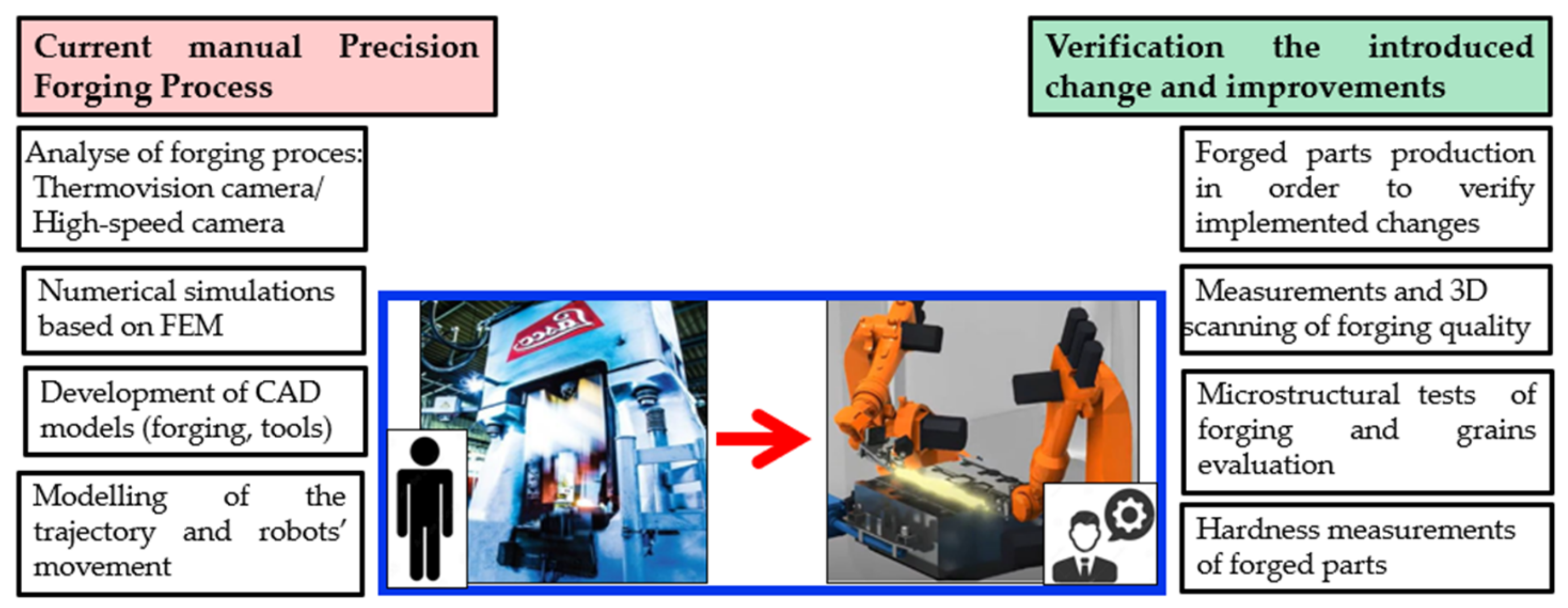
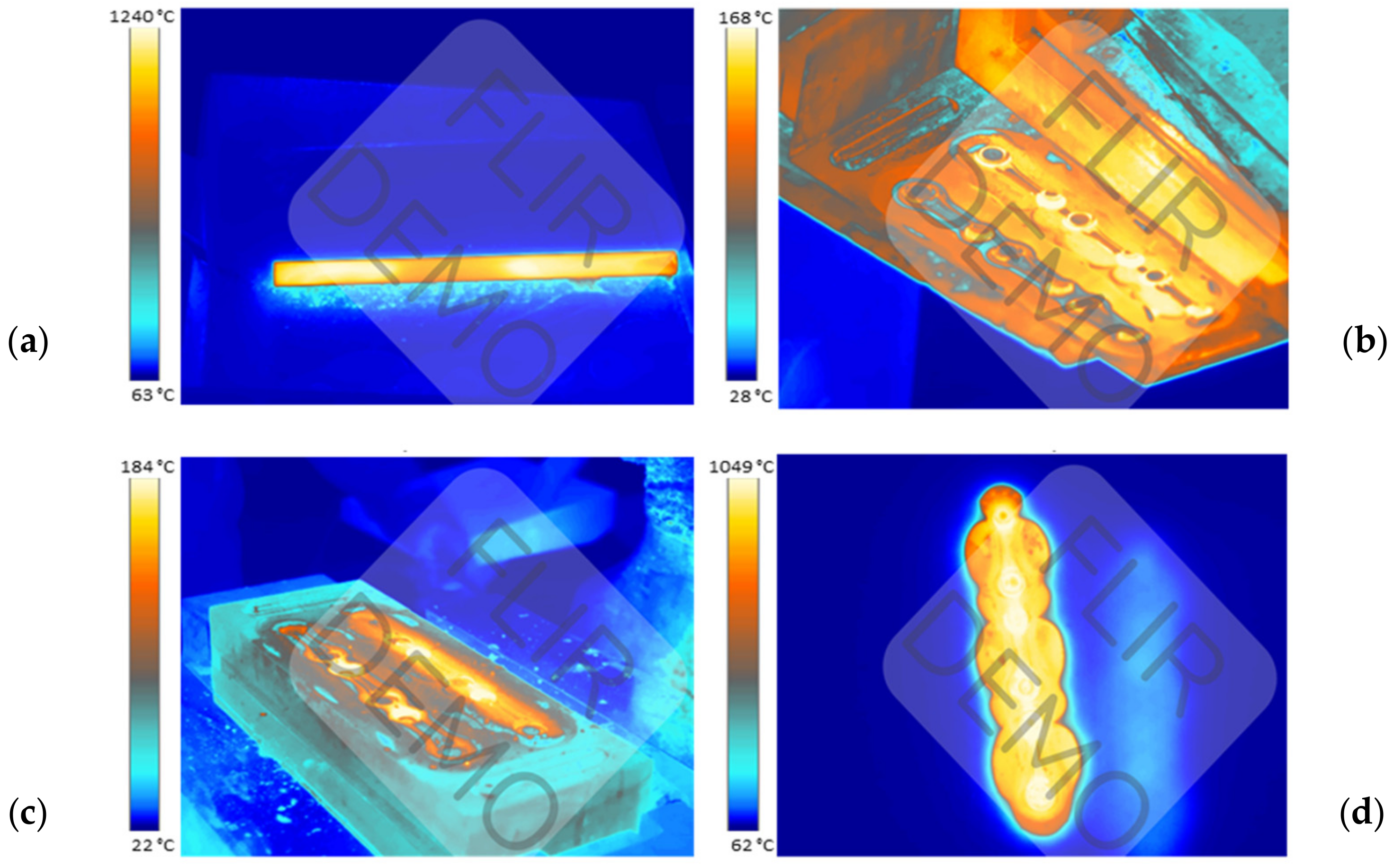
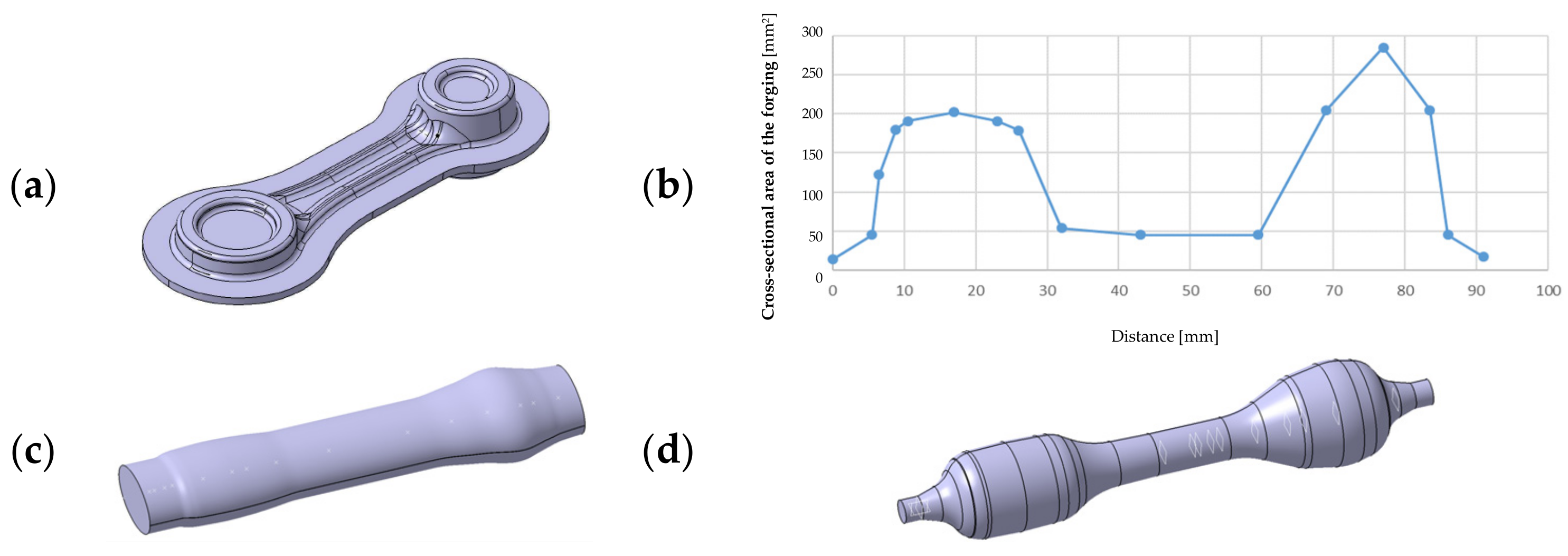
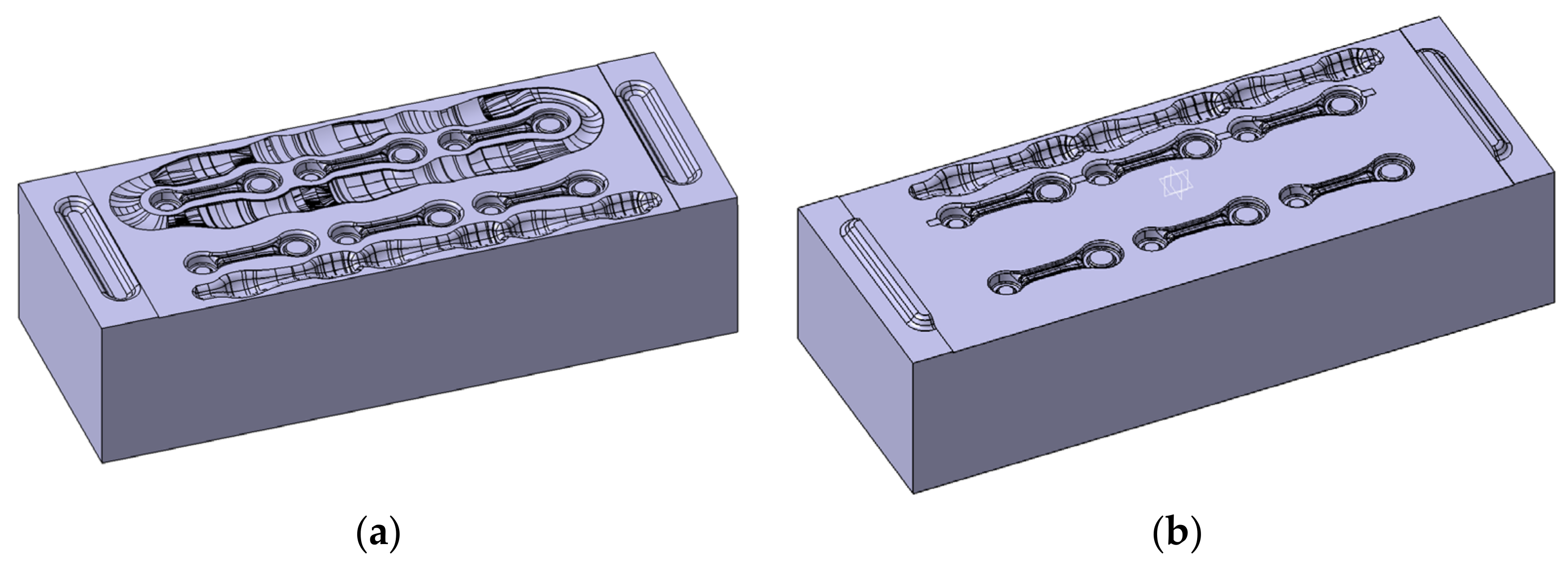
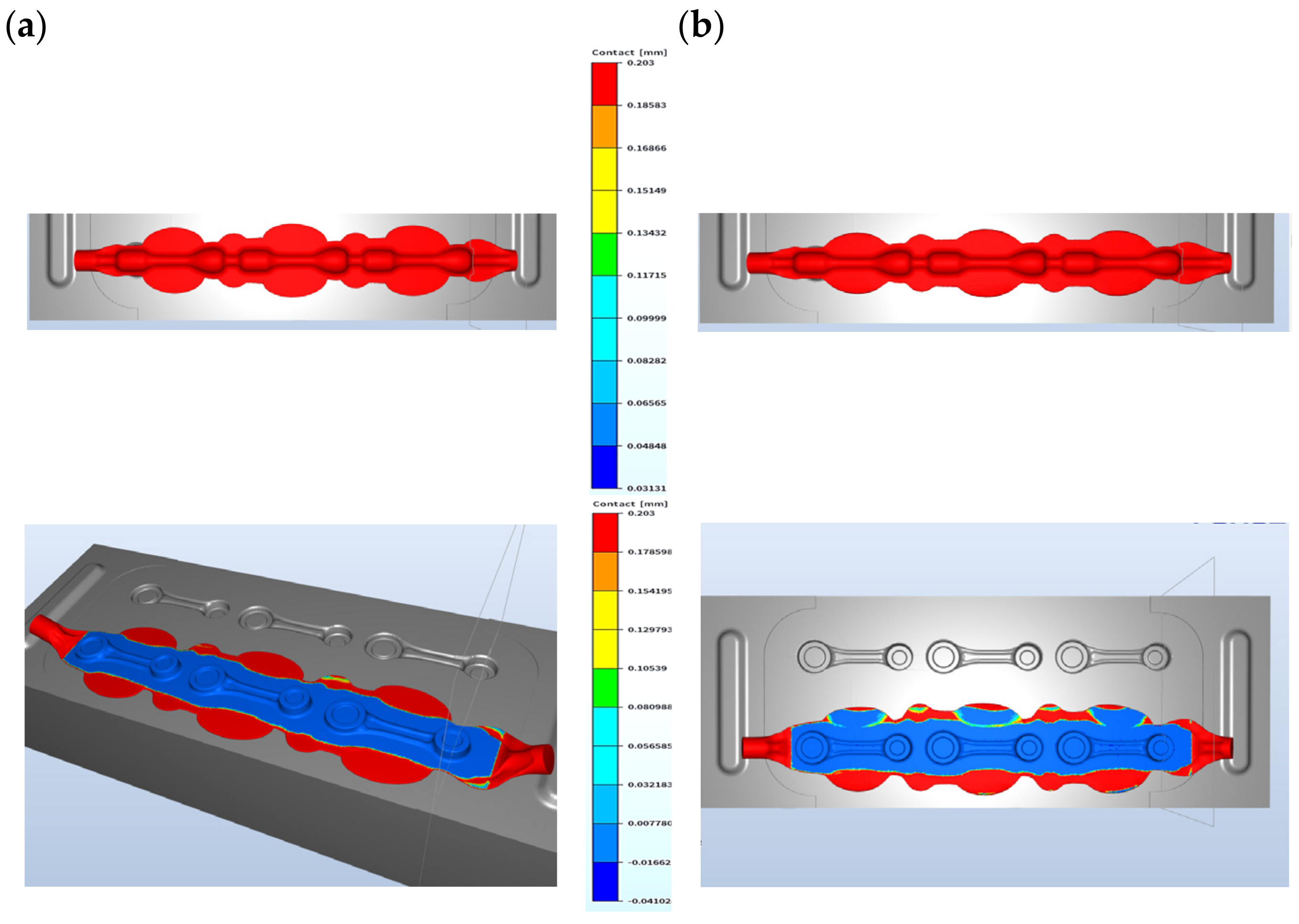

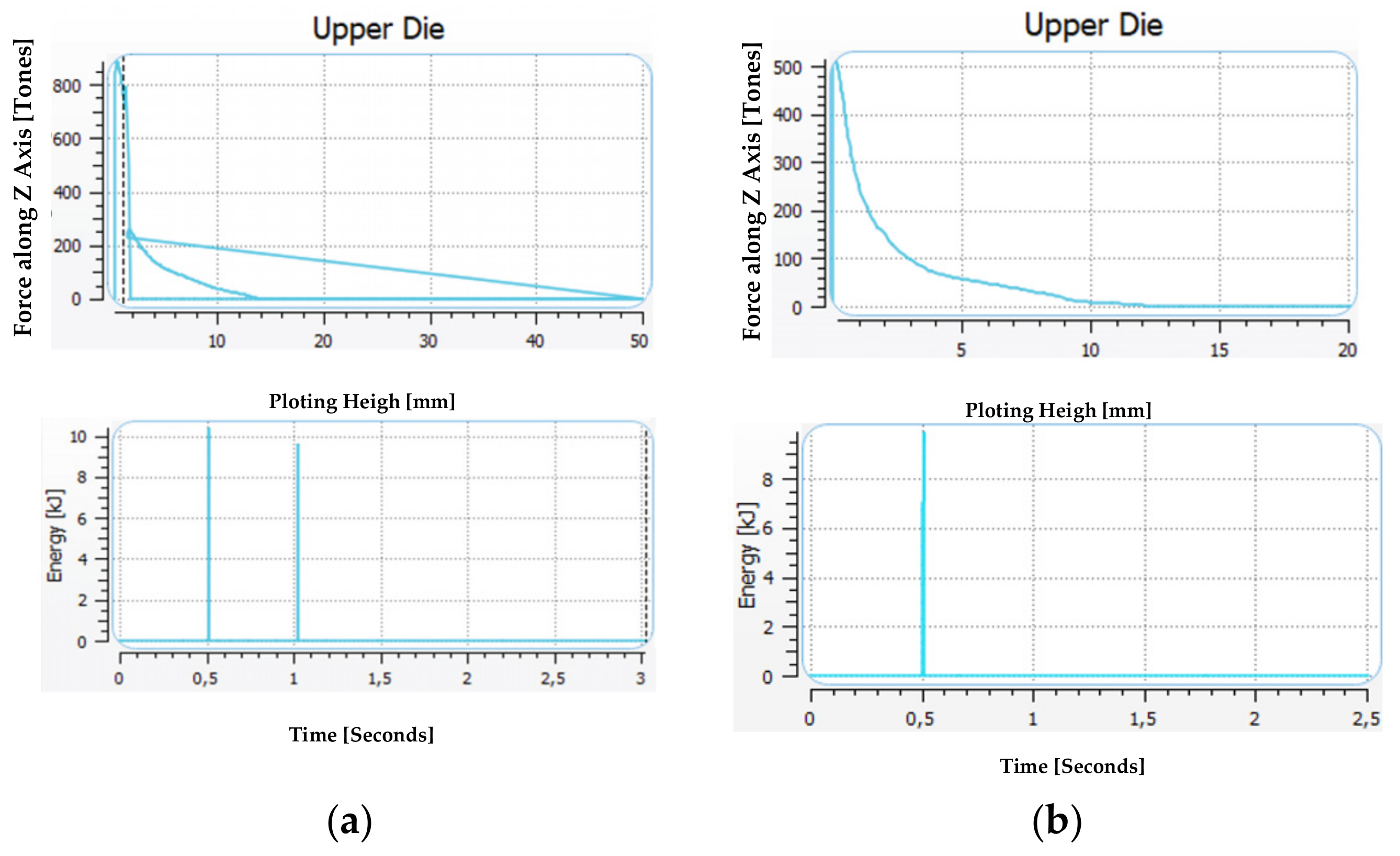
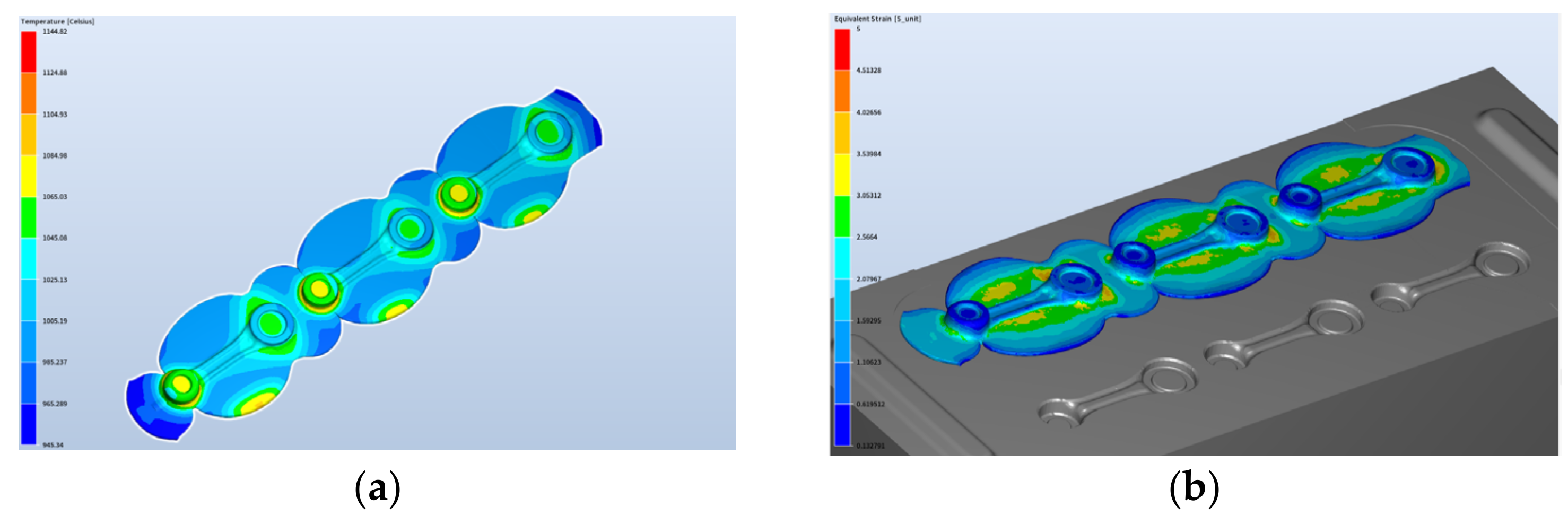

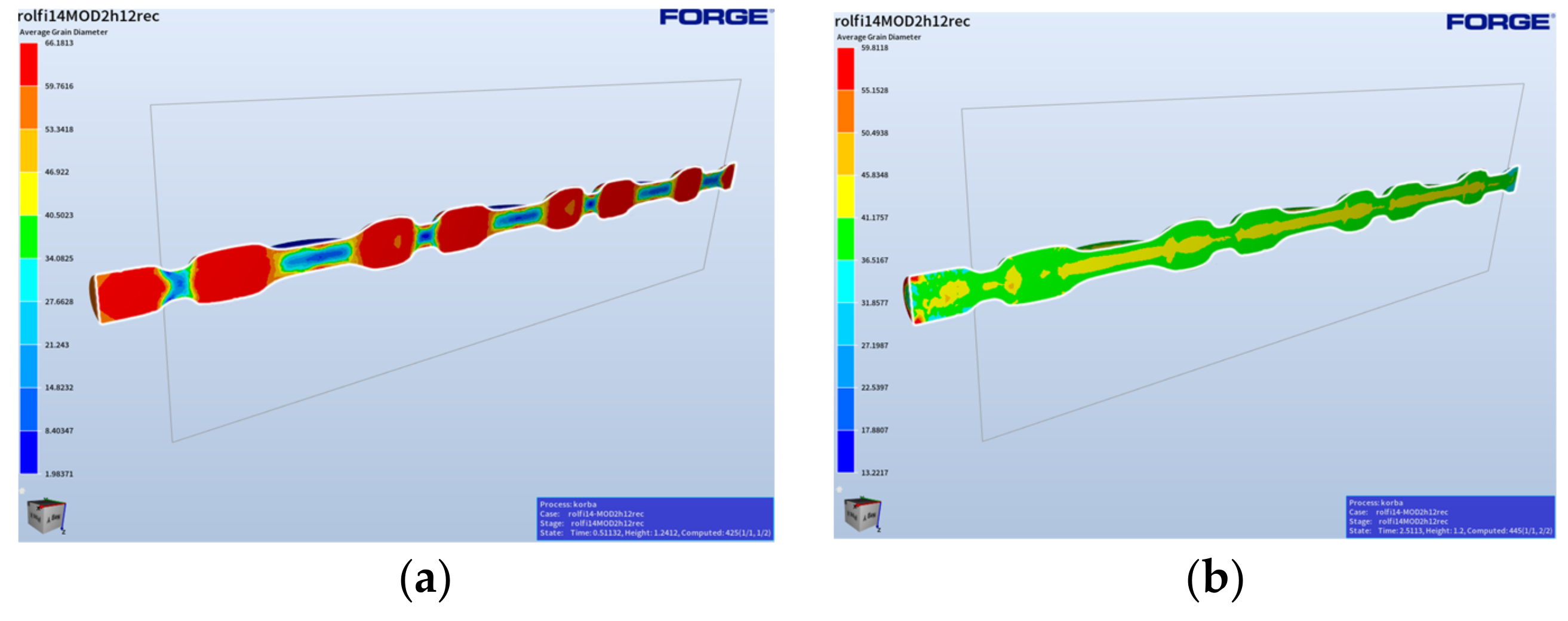
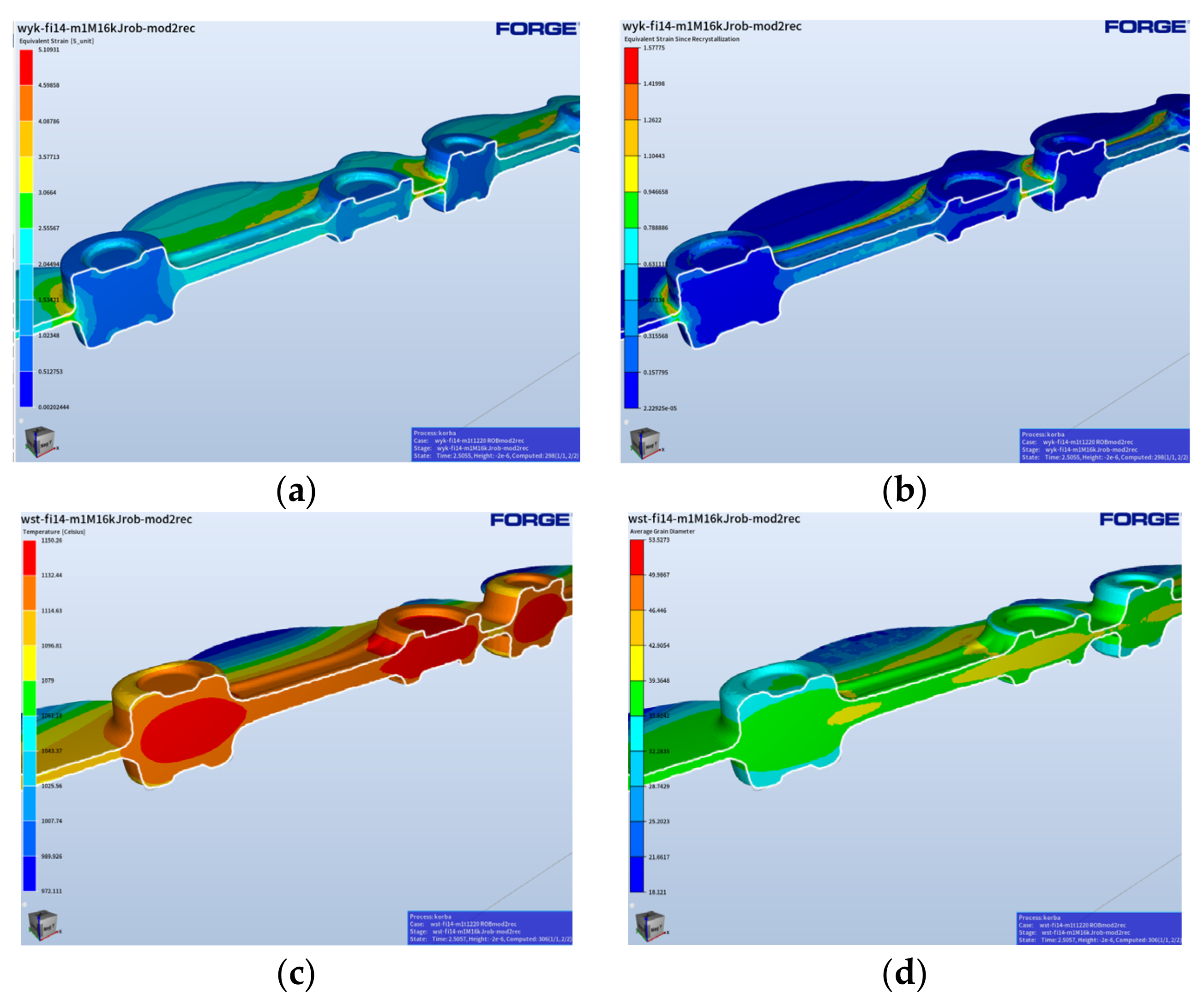
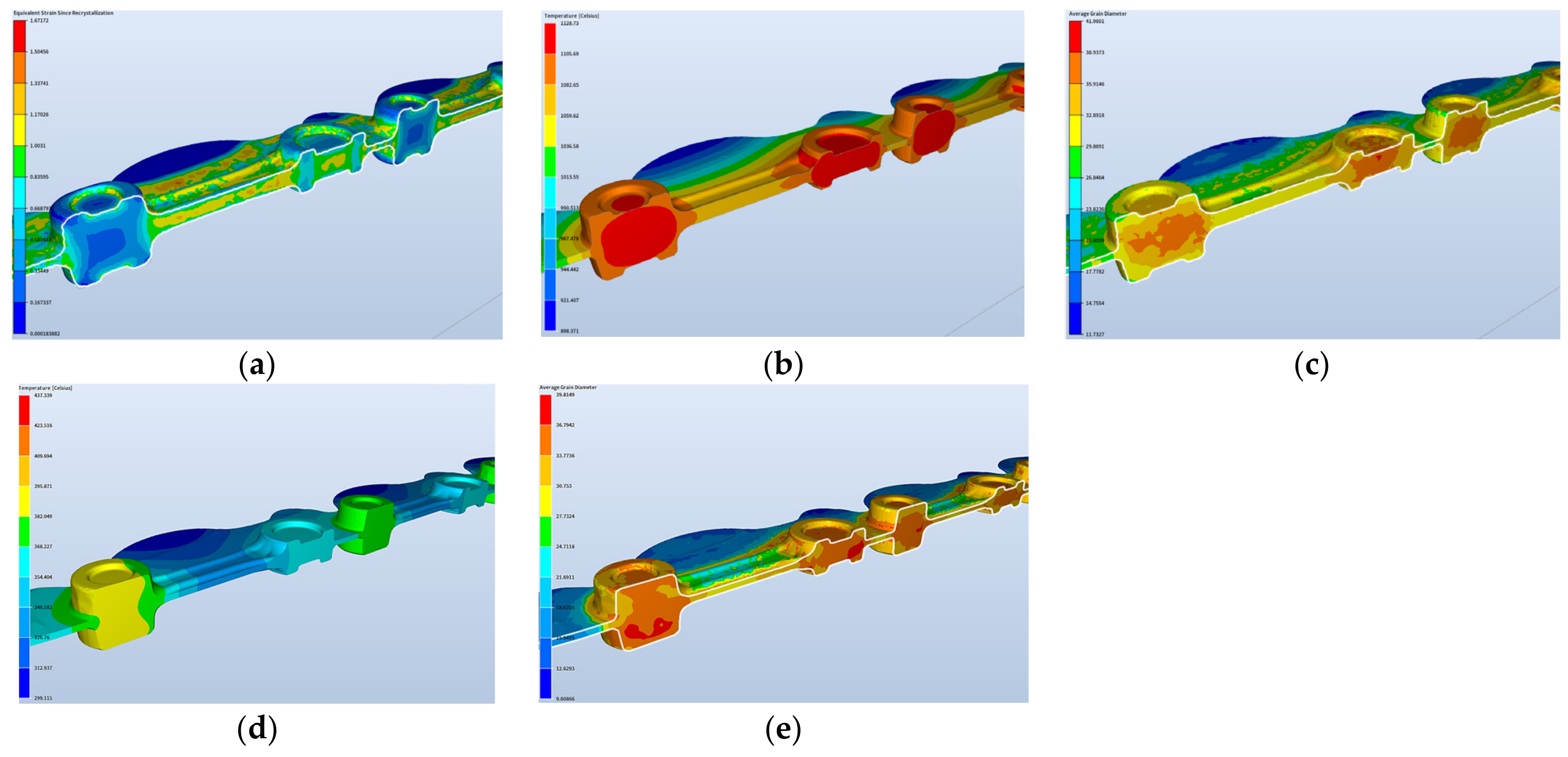

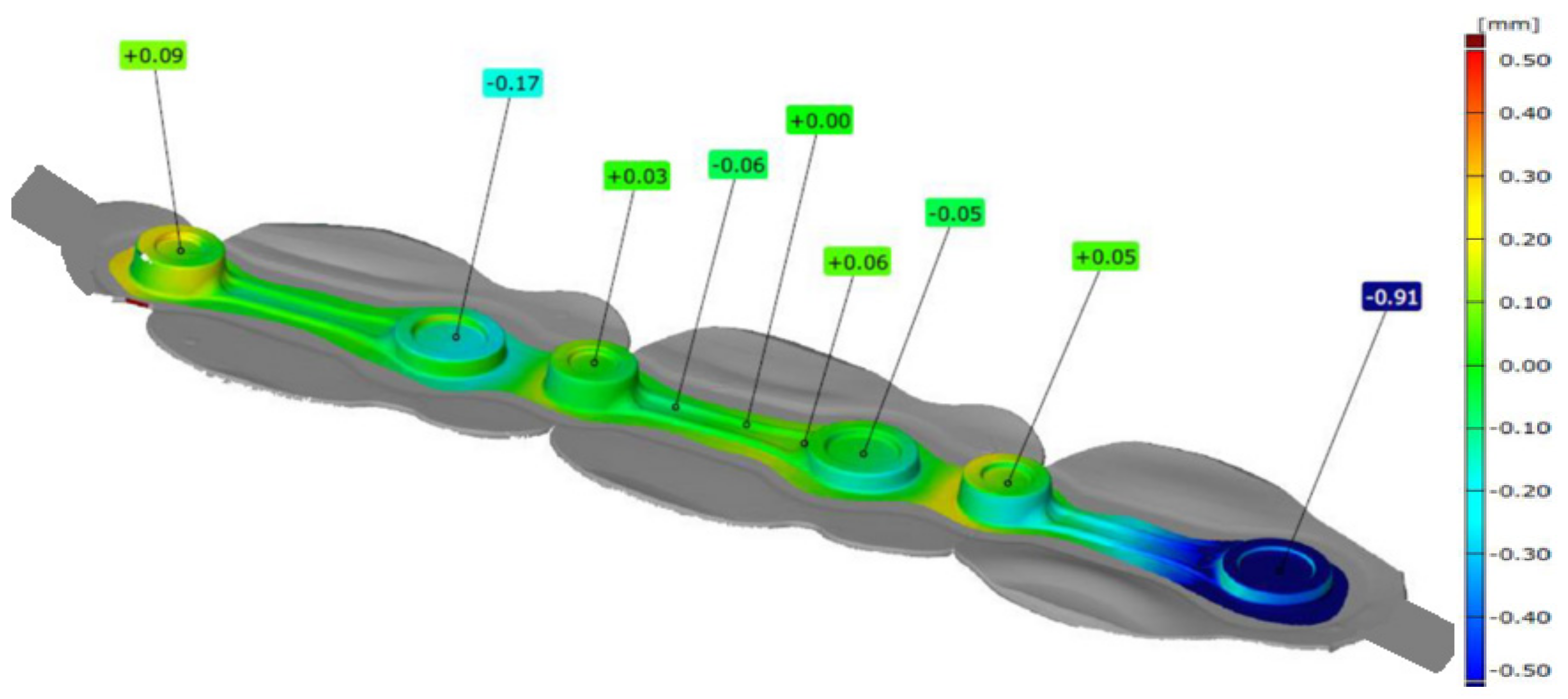


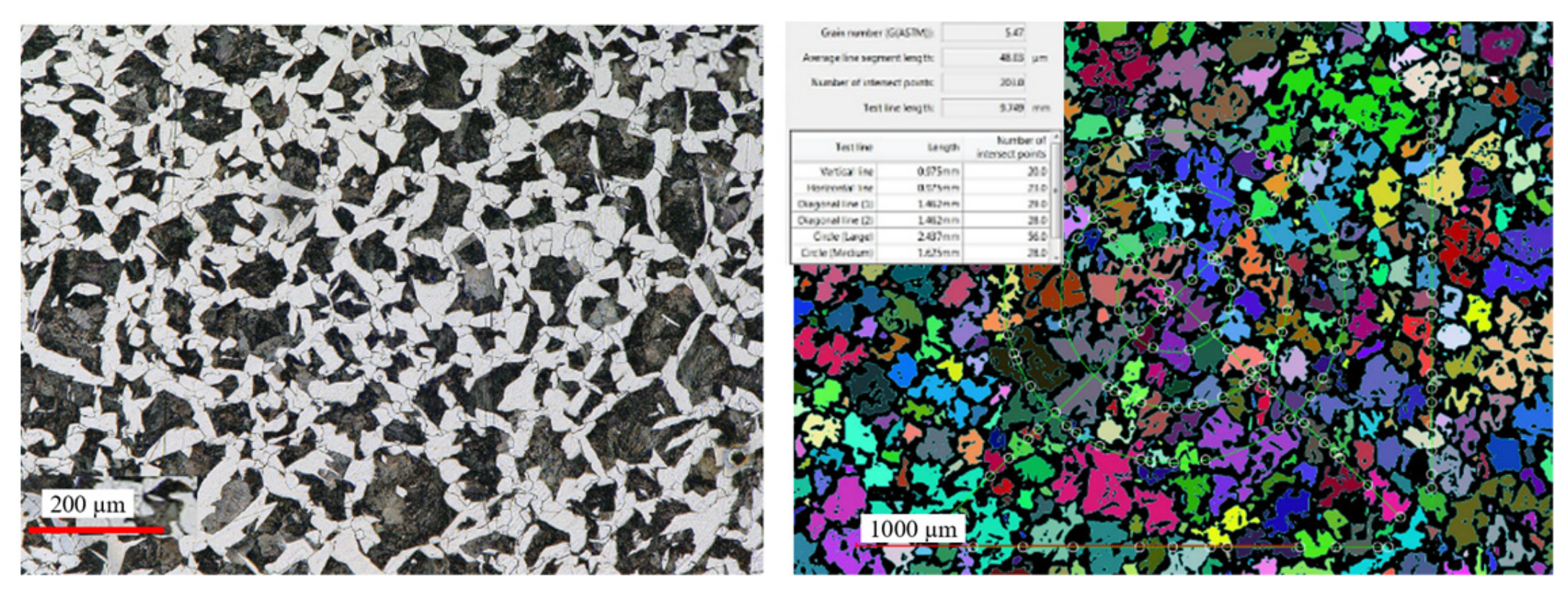
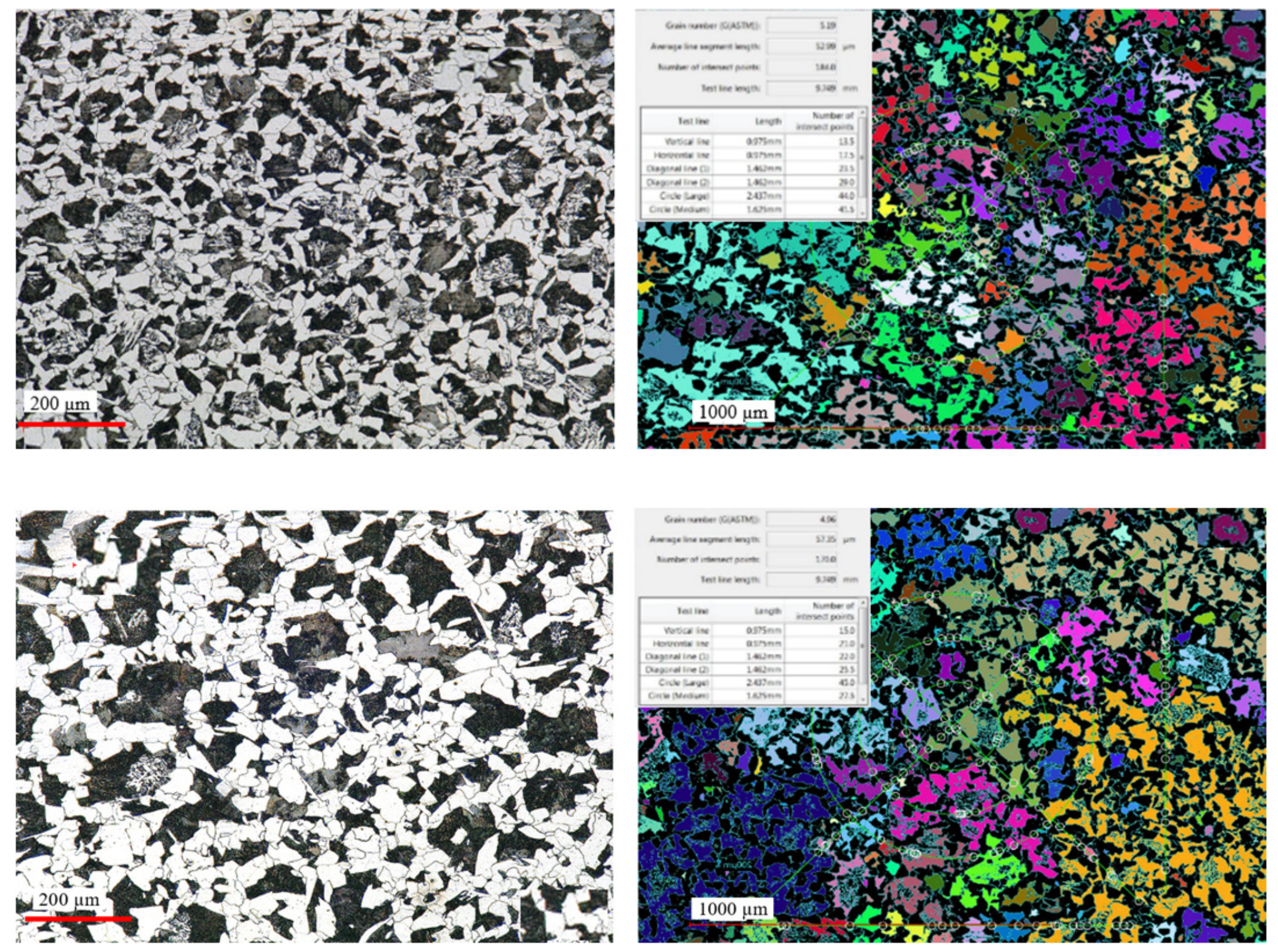
| ASTM | 15 | 14 | 13 | 12 | 11 | 10 | 9 | 8 | 7 | 6 | 5 | 4 | 3 | 2 | 1 | 0 |
|---|---|---|---|---|---|---|---|---|---|---|---|---|---|---|---|---|
| Grain size (μm) | 2 | 3 | 4 | 6 | 8 | 11 | 16 | 22 | 32 | 45 | 63 | 90 | 127 | 180 | 254 | 360 |
| The First Attempt | |||||
|---|---|---|---|---|---|
| Dd (mm) 30 ± 0.03 | Dm (mm) 15 ± 0.2 | Tm (mm) 12.5 ± 0.15 | Td (mm) 17.3 ± 0.15 | Deviation (mm) Max 0.3 | |
| 1A | 30.02 | 15.08 | 12.71 | 17.22 | 0.099 |
| 1B | 29.99 | 15.07 | 12.72 | 17.24 | 0.048 |
| 1C | 29.98 | 15.08 | 12.74 | 17.14 | 0.144 |
| 2A | 29.99 | 15.04 | 12.68 | 17.21 | 0.064 |
| 2B | 29.98 | 15.06 | 12.70 | 17.25 | 0.080 |
| 2C | 30.03 | 15.07 | 12.72 | 17.20 | 0.124 |
| The second attempt | |||||
| 1A’ | 30.01 | 15.07 | 12.58 | 17.22 | 0.079 |
| 1B’ | 30.02 | 15.04 | 12.63 | 17.26 | 0.089 |
| 1C’ | 29.98 | 15.04 | 12.58 | 17.23 | 0.162 |
| 2A’ | 29.99 | 15.05 | 12.58 | 17.23 | 0.029 |
| 2B’ | 29.98 | 15.06 | 12.67 | 17.28 | 0.060 |
| 2C’ | 30.02 | 14.84 | 12.61 | 10.25 | 0.127 |
| The last attempt | |||||
| 3A” | 29.99 | 15.05 | 12.60 | 17.19 | 0.028 |
| 3B” | 29.98 | 15.06 | 12.61 | 17.25 | 0.075 |
| 3C” | 30.03 | 15.04 | 12.59 | 17.20 | 0.180 |
| 3A” | 30.01 | 15.07 | 12.58 | 17.20 | 0.029 |
| 3B” | 30.02 | 15.06 | 15.62 | 17.27 | 0.082 |
| 3C” | 29.98 | 15.06 | 12.60 | 17.23 | 0.039 |
| Sample | Microstructure | Grain of Former Austenite PN-EN ISO 643:2020 [49] | Hardness HB | Decarburization Zone |
|---|---|---|---|---|
| 3-Dd | ferrite + pearlite, ferrite present on grain boundaries | 4.5 | 175 | None |
| 3-Ds | ferrite on grain boundaries + pearlite + bainite | 5 | 175 | None |
| 3-Dm | bainite + ferrite on grain boundaries + traces of pearlite | 5 | 190 | None |
Disclaimer/Publisher’s Note: The statements, opinions and data contained in all publications are solely those of the individual author(s) and contributor(s) and not of MDPI and/or the editor(s). MDPI and/or the editor(s) disclaim responsibility for any injury to people or property resulting from any ideas, methods, instructions or products referred to in the content. |
© 2024 by the authors. Licensee MDPI, Basel, Switzerland. This article is an open access article distributed under the terms and conditions of the Creative Commons Attribution (CC BY) license (https://creativecommons.org/licenses/by/4.0/).
Share and Cite
Hawryluk, M.; Dudkiewicz, Ł.; Polak, S.; Barełkowski, A.; Miżejewski, A.; Szymańska, T. Improvement of the Technology of Precision Forging of Connecting Rod-Type Forgings in a Multiple System, in the Aspect of the Possibilities of Process Robotization by Means of Numerical Modeling. Materials 2024, 17, 1087. https://doi.org/10.3390/ma17051087
Hawryluk M, Dudkiewicz Ł, Polak S, Barełkowski A, Miżejewski A, Szymańska T. Improvement of the Technology of Precision Forging of Connecting Rod-Type Forgings in a Multiple System, in the Aspect of the Possibilities of Process Robotization by Means of Numerical Modeling. Materials. 2024; 17(5):1087. https://doi.org/10.3390/ma17051087
Chicago/Turabian StyleHawryluk, Marek, Łukasz Dudkiewicz, Sławomir Polak, Artur Barełkowski, Adrian Miżejewski, and Tatiana Szymańska. 2024. "Improvement of the Technology of Precision Forging of Connecting Rod-Type Forgings in a Multiple System, in the Aspect of the Possibilities of Process Robotization by Means of Numerical Modeling" Materials 17, no. 5: 1087. https://doi.org/10.3390/ma17051087
APA StyleHawryluk, M., Dudkiewicz, Ł., Polak, S., Barełkowski, A., Miżejewski, A., & Szymańska, T. (2024). Improvement of the Technology of Precision Forging of Connecting Rod-Type Forgings in a Multiple System, in the Aspect of the Possibilities of Process Robotization by Means of Numerical Modeling. Materials, 17(5), 1087. https://doi.org/10.3390/ma17051087








